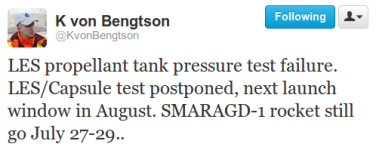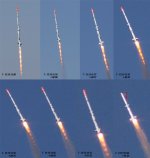You are using an out of date browser. It may not display this or other websites correctly.
You should upgrade or use an alternative browser.
You should upgrade or use an alternative browser.
** The Official Space Flight Thread - The Space Station and Beyond **
- Thread starter Cosimo
- Start date
More options
Thread starter's postsSoldato
http://www.theatlantic.com/technolo...onauts-shot-video-of-the-moon-landing/260122/
Interesting article about how back in 1969 Westinghouse managed to develop the Apollo TV camera, with its Secondary Electron Conduction tube-based sensor, despite the requirements that it had to be operable in temperatures of up to 121˚C and down to -156˚C while drawing only 6.25 watts of electricity.
Interesting article about how back in 1969 Westinghouse managed to develop the Apollo TV camera, with its Secondary Electron Conduction tube-based sensor, despite the requirements that it had to be operable in temperatures of up to 121˚C and down to -156˚C while drawing only 6.25 watts of electricity.
Soldato
When they going to launch it?
http://www.wired.com/wiredscience/2...apsule-and-two-stage-rocket-launch-coming-up/

Soldato
Unbelievably amazing footage from the International Space Station at Night.
http://vimeo.com/45878034
http://vimeo.com/45878034
Watch from 6:10.
13 days and 9 hours to go!
13 days and 9 hours to go!
Can't wait for this sim,hopefully be off work watching the live coverage,we going to do live reports on the landing aww yes

Soldato
Caporegime
- Joined
- 13 Nov 2006
- Posts
- 26,152
So excited about curiosity landing!
Soldato
Nice, so what's their next step after this. I don't see the link between this rocket and the massive one person command modual they're making.
After this (this year) they should, allowing for further complications, be doing the pad abort they've been working towards, another SMARAGD launch with a planned apogee of 60km as opposed to 20km for this one then two SAPPHIRE launches, which will test the active guidance system they've been working on.
It seems to me that SMARAGD is a test of how well their equipment works at high altitude, if they'll be able to track accurately at those speeds and heights and possibly most importantly if they can pull off a successful recovery of the payload. I haven't seen any plans for a rocket that could take Tycho Deep Space to the Kármán line yet. Seems all these tests are trying to figure out what that rocket could practically consist of. Can it have staging? Can it have liquid engines? Can it have active guidance? Do we want all of these? What's the most effective way of combining everything we can do into what we want to make?
Six landings done:
Next one due in 9 days 20 hours.
Next one due in 9 days 20 hours.
Soldato
Soldato
Well... something worked 

Soldato
Something you probably don't want to see in the last frame 

http://www.wired.com/wiredscience/2012/07/smaragd-1-launch-evaluation/


http://www.wired.com/wiredscience/2012/07/smaragd-1-launch-evaluation/


